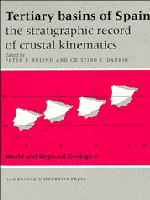Book contents
- Frontmatter
- Contents
- List of contributors
- Preface
- Dedication to Professor Oriol Riba IArderiu
- Memorial, Etienne Moissenet 1941–1994
- PART G GENERAL
- PART E EAST
- PART W WEST
- W1 The Duero Basin: a general overview
- W2 Alpine tectonic framework of south-western Duero basin
- W3 South-western Duero and Ciudad Rodrigo basins: infill and dissection of a Tertiary basin
- W4 Tectono-sedimentary evolution of the Almazán Basin, NE Spain
- W5 Tertiary basins and Alpine tectonics in the Cantabrian Mountains (NW Spain)
- W6 Lacustrine Neogene systems of the Duero Basin: evolution and controls
- W7 North-western Cainozoic record: present knowledge and the correlation problem
- W8 Onshore Cenozoic strike–slip basins in NW Spain
- W9 Tertiary of Central System basins
- PART C CENTRE
- PART S SOUTH
- Index
W3 - South-western Duero and Ciudad Rodrigo basins: infill and dissection of a Tertiary basin
Published online by Cambridge University Press: 04 August 2010
- Frontmatter
- Contents
- List of contributors
- Preface
- Dedication to Professor Oriol Riba IArderiu
- Memorial, Etienne Moissenet 1941–1994
- PART G GENERAL
- PART E EAST
- PART W WEST
- W1 The Duero Basin: a general overview
- W2 Alpine tectonic framework of south-western Duero basin
- W3 South-western Duero and Ciudad Rodrigo basins: infill and dissection of a Tertiary basin
- W4 Tectono-sedimentary evolution of the Almazán Basin, NE Spain
- W5 Tertiary basins and Alpine tectonics in the Cantabrian Mountains (NW Spain)
- W6 Lacustrine Neogene systems of the Duero Basin: evolution and controls
- W7 North-western Cainozoic record: present knowledge and the correlation problem
- W8 Onshore Cenozoic strike–slip basins in NW Spain
- W9 Tertiary of Central System basins
- PART C CENTRE
- PART S SOUTH
- Index
Summary
Abstract
In the south-western sector of the intracontinental Duero Basin, the post-Hercynian sedimentary record consists of Upper Cretaceous to Quaternary terrestrial sediments. Climates shifted from tropical, with poorly defined seasons (end of Cretaceous), to Mediterranean (Neogene). Tertiary deposits are divided into three tectonostratigraphic complexes. The Late Cretaceous–Paleocene, related to the end of the Mesozoic cycle, is characterised by a well-developed weathering profile that was eroded later. The Eocene–Oligocene, formed during the morpho-structural definition of the actual basin boundaries, consists of three unconformity-bounded units related to successive tectonic events of the Alpine Orogeny; by the end of this cycle, progressive incision of the Atlantic fluvial network led to capture of the fluvial systems of the southern Duero Basin and degradation (emptying) began. The Miocene–Pliocene, related to an extensional tectonic regime, represents the spreading of exorheic conditions to the whole basin that marked a complete hydrographic reorganisation. Deposition and aggradation continued in more central areas of the basin until the end of the Neogene, coeval with degradation of the south-western corner of the Duero Basin. The coexistence resulted from differential subsidence, hinge lines (uplift zones) separating sub-basins, and the dynamics of capture processes.
Introduction
The Duero Basin has been considered as an intracratonic basin (sensu Sloss & Speed, 1974). 1974). Its north, south and east margins are moderately technically active mountain ranges, whereas the western boundary is a relatively flat Hercynian border that remained essentially passive during Cainozoic times (Fig. 1). Outcrops of Paleogene sediments occur only at the edges of the basin, whereas Neogene deposits are best represented towards the inner parts of the basin.
- Type
- Chapter
- Information
- Tertiary Basins of SpainThe Stratigraphic Record of Crustal Kinematics, pp. 196 - 202Publisher: Cambridge University PressPrint publication year: 1996



